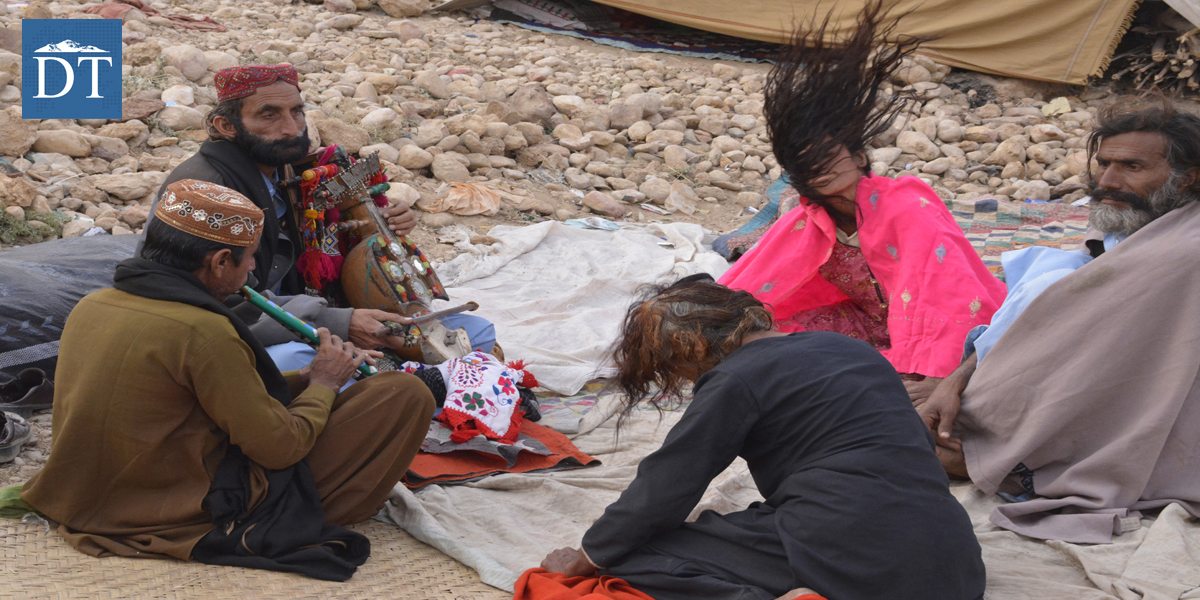Thousands visit Faqeers of Gaji Shah for exorcism of ‘possessed relatives’


GAJI SHAH, DADU: Around a dozen men and women sit on a rali, a quilt associated with Sindhi culture for its colourful patterns, in a courtyard forming a circle around two musicians playing Algozo and Sarangi instruments.
Standing inside the circle, a middle-aged woman kowtows in front of musicians. Soon, she starts whirling in circles and tossing her head and hair.


Sabhagi Khatoon is mother of four. She lives with her family in Balochistan’s Jhal Magsi area and visits Pir Ghazi Shah’s, alias Gaji Shah, shrine in Kherthar Hills every year, sometimes twice a year, to ‘calm down djinns who have possessed her for long’.
Khatoon’s family believes that her frequent bouts of shouting and crying, and occasional loss of consciousness, is due to possession by a djinn. The Faqeers at the shrine are believed to have healing powers.
So every year, the family undertakes around 250 mile journey to the shrine located on an isolated hill of Kherthar Mountain Range in the Kachho region of Dadu near Sindh-Balochistan border at least once during the three-day annual urs. This year, the urs concluded on February 13.
At the shrine, they join hundreds of other families with some member with similar symptoms. The pir, considered the ‘King of Djinn’, ‘heals’ these patients by making them dance on the beat of musical instruments in a state of trance.
The djinns possess people without discriminating among them based on gender.
Muhammad Ramzan, 50, was brought to the shrine this year from a small village in Muzafargarh district of Punjab. “When I dance, I feel so light and the djinn’s effects started going away,” Ramzan told Daily Times.
After the ritual dance, the Faqeers of Gaji Shah take vows from the ‘djinn’ possessing to come back to the shrine next year. The possessed is cursed with harm if they don’t return to the shrine to perform the ritual dance next year.
Faqeer Barkat Ali, the caretaker of the shrine, says that every year around 500,000 to 800,000 people visit them from Sindh, Balochistan, and Southern Punjab. Gaji Shah is believed to have been martyred around two hundred year ago near Shahdadkot city of Sindh during a war known among the locals as Mainwal Tahreek, during Kalhora rule in Sindh.
During the three-day urs, devotees from far-flung areas come and set up makeshift huts atop the hill around the shrine complex. They cook, dance and listen to music for three days.
Well decorated makeshift markets are established where sweets, dry fruits, toys, jewellery, and ornaments are sold. A circus and a death-well is also set up during urs every year.
Based on symptoms shown by the visitors, psychologists explain their condition as ‘conversion dissociative disorder’.
They say treatment at a mental health facility can help these patients get rid of these symptoms permanently.
About the dance ritual at the shrine, they say it exhausts patients, making them feel relieved. “When someone is suffering with such a disorder, the psychological distress is converted into physical distress during the dance. The physical exhaustion makes them feel good,” says Dr Lakesh Khatri, who runs a renowned private mental health facility called Khatri Medical Centre in Karachi. He says that on occasions patients recover on their own, and this lends to the perception that the pir has a healing affect.
Pictures from the 3 day urs at Gaji Shah
Leave a Comment